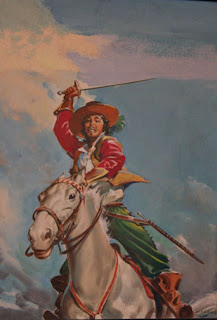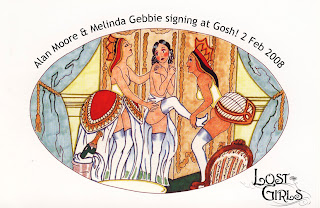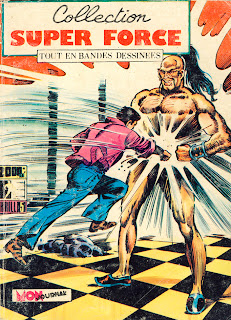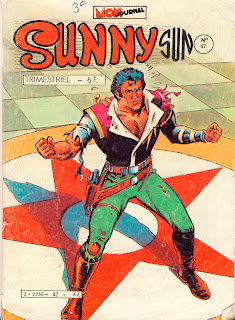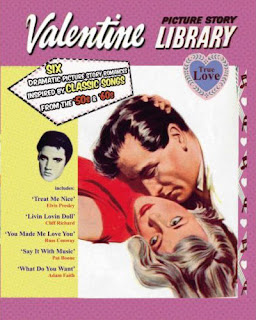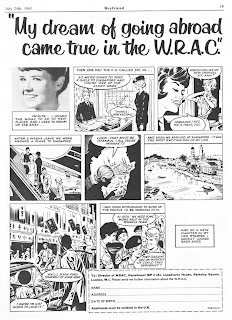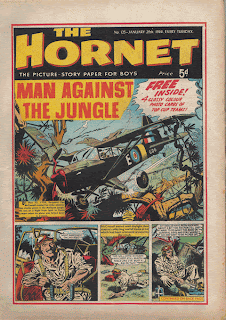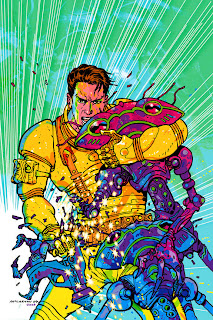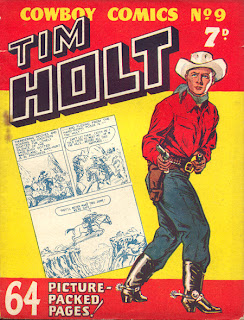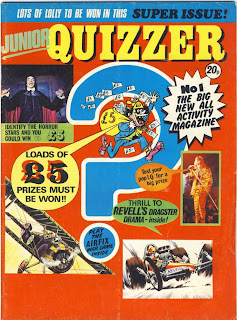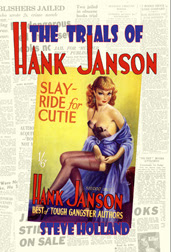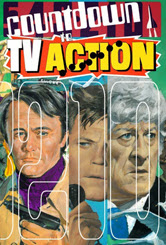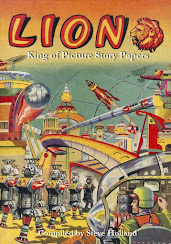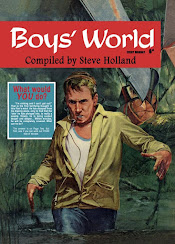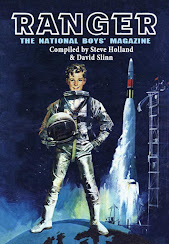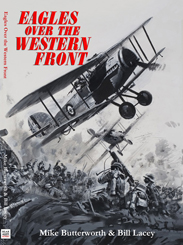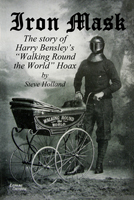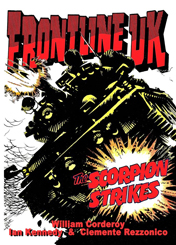(* I've been able to update some of the information presented here thanks to Karen Davis Cunningham. I'll post the additional information below the original post, which begins... now...)
On one of the groups I'm a member of (mostly as a lurker since I spend most of my spare writing time here) I found a post relating to American pulp writer Frederick C. Davis which claimed (with some authority, I might add) that Davis had penned Westerns using the name Hal Dunning following that author's death. Since I'm interested in Davis (he had some paperbacks published here in the UK) I thought I'd look up Dunning's date of death.
Couldn't find it. The Library of Congress lists his year of birth as 1907 but I couldn't find anything else about him. The
Fictionmags Index lists a whole bunch of stories but no dates. And you know me... that's a challenge!
So... Hal Dunning was born Harold Wolcott Dunning in Detroit, Michigan, on 27 September 1880. (Not 1907!)
I'm not sure if his father died or his parents divorced, but Dunning's mother was married to James Charles Meredith, of Detroit, and subsequently moved to Switzerland.
In 1906, Dunning was an automobile salesman living in Cedarhurst, N.Y. A few years later, in 1910, he left the United States and moved to France where he was occupied as a writer, selling most of his stories to American magazines; what he was writing at that time I've no idea since the earliest story in the FM Index lists dates from 1927.
In Paris he met Cicely D'Olier Wyatt, an Englishwoman born in Cuckfield, Sussex, on 7 June 1883, and they married on 27 December 1913; a daughter, Catherine Candide Dunning, was born on 13 November 1914. The three were living at 136 rue d'Assas, Paris, when the war broke out and, in 1915, the Dunning family moved to Switzerland. They subsequently moved to the United States in 1917 where Hal Dunning joined up.
After the war, Dunning and his family were living at South Bristol, Lincoln, Maine. At the time of the 1930 census, Dunning was boarding in Westport, Fairfield, CT.
The FM Index indicates that Dunning was a prolific contributor to
Complete Stories, a Street & Smith pulp, until 1934 after which his name disappears; it reappears in
Wild West Weekly in 1940-43. This patchy output could simply be due to a lack of an index for the magazines Dunning wrote for or that Dunning turned out stories under pseudonyms.
I've yet to discover when Dunning died but I guess this is a start. One thread I have been able to follow to the end is Dunning's first wife: after living in Connecticut in the 1930s to the 1950s, Cicely Dunning died in February 1967 at Saint Thomas in the Virgin Islands.
What's interesting is that Dunning's work continues to appear in print. For an author whose hey day was a five-year period from 1927-31 that's pretty good. The latest edition of his first novel,
The Outlaw Sheriff (in which the hero, known as the White Wolf, has to take over his sick brother's position as sheriff) is due to be reissued in only a couple of day's time, according to Amazon and a number of his novels have appeared in large print in the last couple of years.
Novels (series: White Wolf in all)
The Outlaw Sheriff. New York, Chelsea House, 1928; London & Melbourne, Ward, Lock & Co., 1934.
White Wolf's Law. New York, Chelsea House, 1928; London & Melbourne, Ward, Lock & Co., 1934.
White Wolf's Pack. New York, Chelsea House, 1929; London & Melbourne, Ward, Lock & Co., 1934.
The Wolf Deputy. New York, Chelsea House, 1930; London & Melbourne, Ward, Lock & Co., 1935.
White Wolf's Feud. New York, Chelsea House, 1930; London & Melbourne, Ward, Lock & Co., 1935.
White Wolf's Outlaw Legion. New York, Chelsea House, 1933; London & Melbourne, Ward, Lock & Co., 1935.
OmnibusThe White Wolf Western Omnibus (contains
The Outlaw Sheriff,
White Wolf's Law,
White Wolf's Pack). London & Melbourne, Ward, Lock & Co., 1951.
UPDATE: 29 January 2008The post that inspired this bit of research came from Karen Davis Cunningham, granddaughter of Frederick C. Davis and Karen has kindly added some further information.
"The story that was told to me is that when Hal Dunning died, Street & Smith (the publisher) did not want to discontinue the stories he was writing because he was so popular and purposely kept his death quiet. They asked my grandfather to take over writing his stories, continuing under Hal Dunning's name, and Dunning's widow got a percentage of the proceeds. I originally heard this information from Jon Tuska (who is with Golden West publications), which others have since confirmed.
"To my knowledge, there were 30 stories that my grandfather wrote under the name Hal Dunning, all in
Complete Stories. I was aware that there were stories in
Wild West Weekly, but I'm not sure if these were new ones or reprints of stories previously published.
"In an interesting note, my grandfather also lived in Westport, CT, in 1930 (according to the census). I hear it was quite a haven for writers at that time. I don't know if he knew Dunning personally."
Thanks to Karen I can also list all the stories written by Frederick C. Davis under the Hal Dunning name. I've taken some additional information of Dunning's output from the
Fictionmags Index which, although incomplete, is by far the best listing of its type.
Stories by Hal DunningThe White Wolf (
Complete Stories, Feb 1927)
Jim Allen Rides to Down (
Complete Stories, Mar 1927)
Nemesis of the Range (
Complete Stories, Apr 1927)
The Outlaw Sheriff (
Complete Stories, May 1927)
In the Blizzard (
Complete Stories, Jun 1927)
The Killer and the Kid (
Complete Stories, Jul 1927)
Nesters' Rights (
Complete Stories, Aug 1927)
The Call of the Pack (
Complete Stories, Oct 1927)
Jim-Twin Allen Comes to Town (
Complete Stories, Dec 1927)
The Wolf Rides Again (
Complete Stories, Feb 1928)
The House of Sinister Men (
Complete Stories, Mar 1928)
When a Wolf Howls (
Complete Stories, Apr 1928)
Outlaws' Law (
Complete Stories, May 1928)
Son of a Fightin' Fool (
Complete Stories, Jun 1928)
Buzzards' Meat (
Complete Stories, Jul 1928)
Judgment of the Desert (
Complete Stories, Aug 1928)
The Call of the Fire (
Complete Stories, Sep 1928)
Nothin' But a Rope (
Complete Stories, Sep 1928)
Give 'Em Lead (
Complete Stories, (1st) Oct 1928)
The Wolf That Makes His Kill (
Complete Stories, (2nd) Oct 1928)
The Last of the Deans (
Complete Stories, (2nd) Nov 1928)
To Hell and Back (
Over the Top, Nov 1928)
Waiting Vengeance (
Complete Stories, (1st) Dec 1928)
No Trespass (
Complete Stories, (2nd) Dec 1928
)
Nothing to Report (
Over the Top, Dec 1928)
Jim Allen, Gentleman (
Complete Stories, (2nd) Jan 1929)
For the Last Time (
Complete Stories, (1st) Feb 1929)
Like a Gent (
Western Story Magazine, 23 Feb 1929)
The Tiger of the Border (
Complete Stories, (2nd) Mar 1929)
The Blood Trail (
Complete Stories, (2nd) May 1929)
The Ranger and the Rose (
Complete Stories, (2nd) Jun 1929)
Bread on the Waters (
Complete Stories, (2nd) Jul 1929)
An Even Chance (
Complete Stories, (1st) Aug 1929)
The Ghost of the Wolf (
Complete Stories, (1st) Sep 1929)
Not Worth Killin' (
Complete Stories, (1st) Oct 1929)
"Regular an' Lawful" (
Complete Stories, (2nd) Oct 1929)
Just a Man (
Complete Stories, (1st) Nov 1929)
The Lion and the Mouse (
Complete Stories, (2nd) Nov 1929)
Two of a Kind (
Complete Stories, (1st) Dec 1929)
A Case of Psychology (
Complete Stories, (2nd) Dec 1929)
In His Own Web (
Complete Stories, (1st) Jan 1930)
The Word of the Wolf (
Complete Stories, (2nd) Jan 1930)
A Man's Country (
Complete Stories, (1st) Feb 1930)
Wolf Poison (
Complete Stories, (2nd) Feb 1930)
Horshoes For Luck? (
Complete Stories, (1st) Mar 1930)
The Wolf Pays a Debt (
Complete Stories, (2nd) Mar 1930)
The Left-Handed Shooter (
Complete Stories, (1st) Apr 1930)
The Last Gamble (
Complete Stories, (2nd) Apr 1930)
A Pat Hand (
Complete Stories, (1st) May 1930)
The Long Trail (
Complete Stories, (2nd) May 1930)
The Wolf Goes North (
Complete Stories, (1st) Jun 1930)
As a Man Sows (
Complete Stories, (2nd) Jun 1930)
Runt Justice (
Complete Stories, (1st) Jul 1930)
Lower Than a Snake (
Complete Stories, (2nd) Jul 1930)
Counterfeit Hero (
Complete Stories, (1st) Aug 1930)
Two Innocents in Hurricane Gap (
Complete Stories, (2nd) Aug 1930)
Not Guilty (
Complete Stories, (1st) Sep 1930)
A Real Horse (
Complete Stories, (1st) Oct 1930)
Boomerang (
Complete Stories, (1st) Nov 1930)
Of Their Own Will (
Complete Stories, (2nd) Nov 1930)
The Miracle (
Complete Stories, (1st) Dec 1930)
Tinhorn (
Complete Stories, 15 Nov 1931)
Stories credited to Dunning penned by Frederick C. DavisAccordin' to the Book (
Complete Stories, 1 May 1932)
Ranger King (
Complete Stories, 15 May 1932)
Absentee Justice (
Complete Stories, 1 Jun 1932)
Hangman's Hickory (
Complete Stories, 1 Jul 1932)
No Rangers Wanted (
Complete Stories, 15 Jul 1932)
Wolves Can Climb (
Complete Stories, 1 Aug 1932)
Once an Outlaw (
Complete Stories, 15 Aug 1932)
Coyotes Beware (
Complete Stories, 1 Sep 1932)
Quicksand (
Complete Stories, 15 Sep 1932)
Women Is Sure Peculiar (
Complete Stories, 1 Oct 1932)
Gents Use Guns (
Complete Stories, 15 Oct 1932)
Battle Cry (
Complete Stories, 1 Nov 1932)
Left-Handed Law (
Complete Stories, 15 Nov 1932)
Outlaw Island (
Complete Stories, 1 Dec 1932)
The Christmas of a Wolf (
Complete Stories, 15 Dec 1932)
Hell's Acres (
Complete Stories, 1 Jan 1933)
Two-Spots Can't Win (
Complete Stories, 15 Jan 1933)
Found Gold (
Complete Stories, 1 Feb 1933)
Pardner's Honor (
Complete Stories, 15 Feb 1933)
Destroying Angel (
Complete Stories, 1 Mar 1933)
There's Always Wolves (
Complete Stories, 15 Mar 1933)
For a Friend (
Complete Stories, 1 Apr 1933)
Guns Talk Last (
Complete Stories, 15 Apr 1933)
Hostage Trail (
Complete Stories, 15 May 1933)
High-Water Cache (
Complete Stories, 15 Feb 1934)
Colts Alter Cases (
Complete Stories, 30 Apr 1934)
Golden Pelts (
Complete Stories, 1 Jul 1934)
In Wolf's Clothing (
Complete Stories, 22 Jul 1934)
Hard to Hit (
Complete Stories, 24 Sep 1934)
Possible retitled reprintsWhite Wolf Talks Turkey (
Wild West Weekly, 30 Nov 1940)
White Wolf's Law (
Wild West Weekly, 21 Mar 1942)
Bonanza Bullion (
Wild West Weekly, 12 Sep 1942)
Trigger Twins (
Wild West Weekly, 19 Jun 1943)
From the spread of the stories, it seems likely that Hal Dunning died in 1931 or 1932. It's also likely that the handful of novels that featured the White Wolf were actually collections of connected stories as I can't help noticing that none of the stories listed in the FM Index are longer than a novelette and I would have thought that, had Dunning written a novel featuring his most famous character, it would have been featured in
Complete Stories or one of Street & Smith's other magazines.
UPDATE: 3 February 2008Thanks to John Herrington I now have confirmation that Dunning died on 26 July 1931.
The
Westport Herald for Tuesday, 28 July 1931 carried a notice that Dunning, of Otter Ponds, "died very suddenly on Sunday night in New York City."
"Mr. Dunning, who was a middle-aged man, has been in the best of health and his death was due to an acute heart attack. He is survived by his wife, Cicely, a daughter, Candide, and one sister, Mrs. Schumann.
"Mr. Dunning with his family has been making his home in Westport intermittently for the past four years. He was a short story writer and did a great deal of work for Street & Smith. he has spent a great deal of his life in Paris, although he was born in New York City
(sic - he was born in Detroit, Michegan - SH). His wife is the former Cicely Wyatt of England.
"Funeral arrangements have not yet been made and it had not been decided at press time if the interment would be in Westport or Long Island, where his sister resided."
A
New York Times obituary (which I've not seen) mentions that his brother, Ralph Cheever Dunning, was a poet who died in Paris in 1929 (I've since found a
biographical sketch of Ralph which gives his dates as 1878-1930, although the obituary refers to his death "the year before last"). Dunning was descended, through his father, from a Devonshire family of the 17th century, while, through his mother, he was related to the Wolcott and Cheever families of New England.
Further digging into the census records reveals that Dunning was living in Nassau, New York, in 1900 with his mother (Catherine C., born Sept. 1857) and step-father, James Charles Meredith (b. Sept. 1858), plus brother Ralph Cheever (b. May 1877) and sister Hazel (b. Mar. 1885). Catherine was also an author; born in Michigan of New York parents, she was first married to an Englishman and had four children, of whom only three survived. I believe that she was probably the authoress Katharine Mary Cheever Meredith who contributed to
Harper's and
Colliers and wrote various books including
Sketches from Truth (1892),
Green Gates (1896),
Drumsticks (1897) and
The Wing of Love (1905).

 My last day at Look and Learn (*sniff*), so I thought I'd try to post something apt. And this is it, the last comic strip to appear in Look and Learn magazine back in 1981. Actually, this is the first episode of the last serial and it appeared in issue 1003 (30 May 1981); Look and Learn continued to appear for almost another year, coming to an end with issue 1049 (17 April 1982).
My last day at Look and Learn (*sniff*), so I thought I'd try to post something apt. And this is it, the last comic strip to appear in Look and Learn magazine back in 1981. Actually, this is the first episode of the last serial and it appeared in issue 1003 (30 May 1981); Look and Learn continued to appear for almost another year, coming to an end with issue 1049 (17 April 1982). Although he shares his surname with another comic strip artist, Stanley Houghton, they were apparently unrelated. It is thought that Ken Houghton died some time in the 1980s.
Although he shares his surname with another comic strip artist, Stanley Houghton, they were apparently unrelated. It is thought that Ken Houghton died some time in the 1980s.











